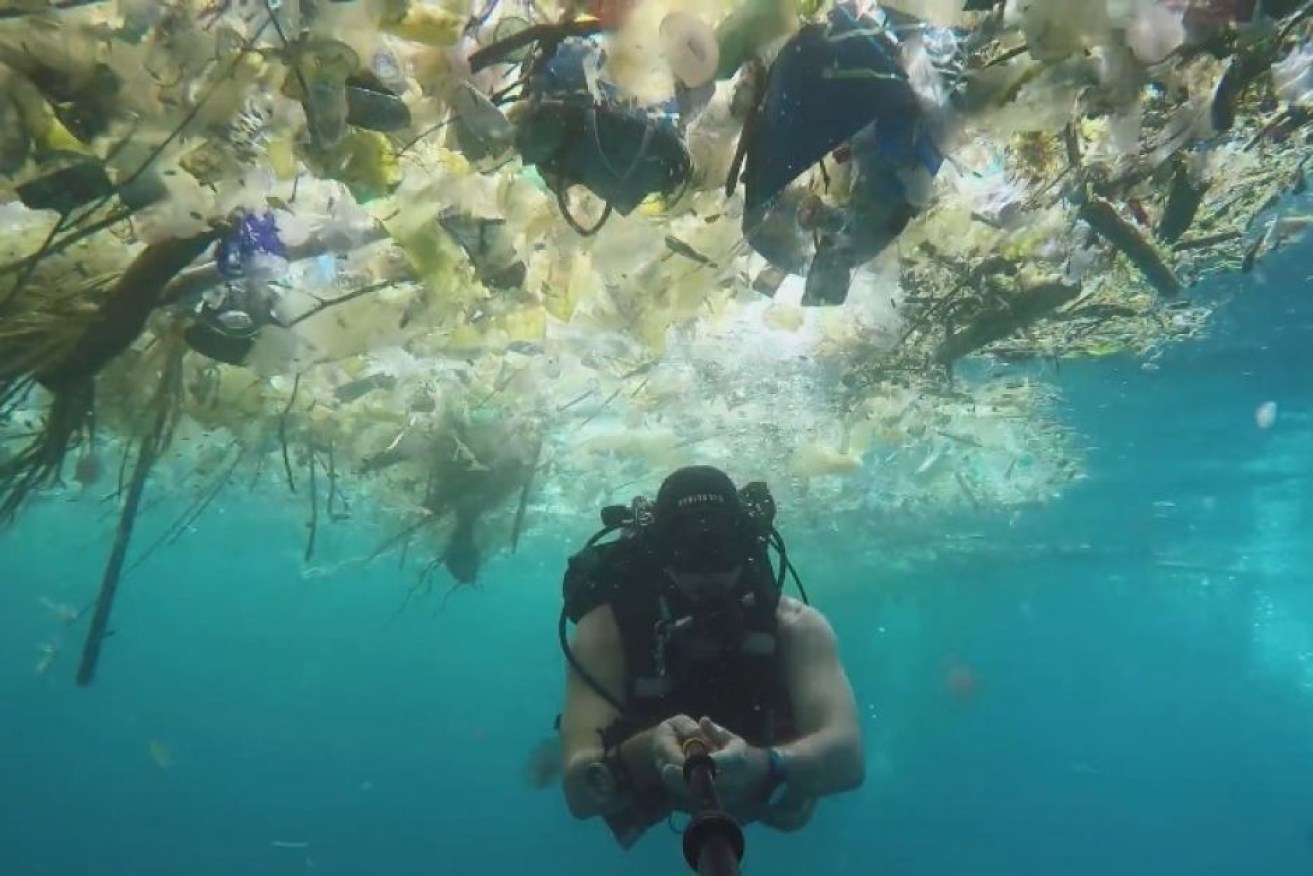Diver films wave of plastic pollution on scale ‘never seen before’

The rubbish is so thick at Manta Point, Indonesia, it forms a solid barrier on the ocean surface. Photo: Rich Horner
A diver who filmed a huge “slick” of plastic floating in clear waters at a popular dive spot in Indonesia said he has “never seen anything like this scale” of ocean pollution before.
In a video uploaded to social media, diver Rich Horner is seen swimming through masses of floating plastic garbage at a dive spot usually frequented by manta rays which come to get cleaned.
Although the dive site lies off the coast of Nusa Penida – a small island with low population – there is a stretch of only 20 kilometres of water separating Nusa Penida from the island of Bali and its capital Denpasar.
“Plastic straws, plastic baskets, plastic bags, more plastic bags, plastic, plastic, so much plastic!” Mr Horner wrote on Facebook.
“Surprise, surprise there weren’t many mantas there at the cleaning station today. They mostly decided not to bother.”
Mr Horner said the level of plastic at that site varied throughout the year, and there was no plastic visible during the dry season but random clouds and slicks appear during the wet season.
He said this trash in the footage had cleared by the next day.
A new study by researchers from Australia, Italy and the US have found tiny plastic particles are a particular threat to “filter-feeding” animals like the manta rays near Bali, which can swallow up to 90 pieces every hour.
Murdoch University lead researcher Elitza Germanov said microplastics – particles smaller than five millimetres long – contain toxic chemicals that, if ingested, could alter biological processes in the animals, such as growth, development and reproduction.
“We are still trying to understand the magnitude of the issue,” Ms Germanov said.
“Microplastic contamination has the potential to further reduce the population numbers of these species, many of which are long-lived and have few offspring throughout their lives.”

The popular dive spot lies off the island of Nusa Penida.
A diet of plastic
Once this trash ends up in the ocean and is swept up by currents, it is virtually irretrievable.
Exposed to saltwater, sunlight and heat, larger plastic pieces will eventually break down into smaller and smaller bits.
Marine filter-feeders like mantas, whales and whale sharks are at risk because of their feeding habits. They swallow thousands of cubic metres of water per day, to capture plankton and other tiny organisms floating in the sea.
Ms Germanov, who is in the final stages of a PhD project through Murdoch University, is focusing on plastic pollution in manta ray feeding grounds around the coastline of Nusa Penida and Komodo National Park in Indonesia.
“Plastics are definitely on the menu here,” she said.
“Our first results indicate that the mantas ingest 40 to 90 pieces of microplastics per hour.”
With the help of a team of local researchers from Udayana University in Bali, she is also collecting samples of egested material and stomach contents of the animals to study their exposure to plastic-associated toxins.
In a last step, the team is conducting a social study, quizzing local communities on their awareness around the issue.
“Raising awareness of this issue in communities, among governing bodies and industries could help to change behaviours around the production, management and use of plastics,” Ms Germanov said.
Tourism could drive change

Manta rays have been identified as at risk from microplastics. Photo: Elitza Germanov/Marine Megafauna Foundation
Janis Argeswara, a marine science student at Udayana University, said she was shocked about the manta rays swimming in a “pile of trash”.
“Bali’s economy depends heavily on tourism for income,” she said.
“If the mantas disappear off Nusa Penida, people here wouldn’t know what to do.”
Large ocean species attract thousands of wildlife enthusiasts to tourism destinations such as Indonesia every year.
They also make up a large part of Australia’s tourism dollars.
And while the waters of south-east Asia are some of the worst affected in terms of plastic waste, rubbish is also entering Australian waters.
Researchers have long found a microplastic hot spot near the World Heritage-listed Ningaloo Reef, which is famous for its whale shark encounters.
“Plastic beads in facial scrubs and toothpastes, which are too small to be filtered during water treatment, are another factor for the pollution,” Ms Germanov said.
Many of the species at risk from microplastics are endangered already.
The world’s largest fish, the whale shark, is listed as vulnerable on the Red List of the International Union for Conservation of Nature, with only 7000 remaining species in 2016.
With a decreasing current population trend, manta rays have also been designated a threatened species.
“I just really want to make a fuss about this and draw attention to these amazing creatures, knowing that they are important to tourism, so that these countries consider protecting their assets,” Ms Germanov said.
-ABC








